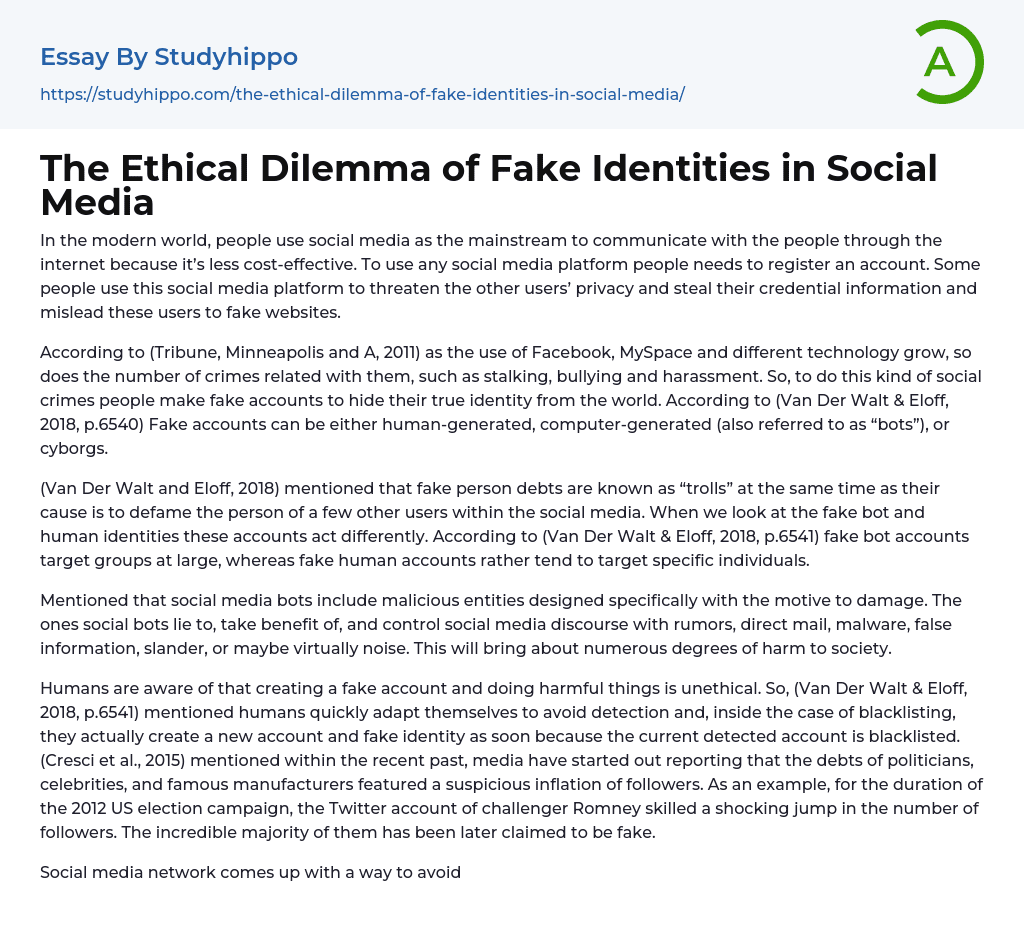

The Ethical Dilemma of Fake Identities in Social Media Essay Example
In the modern world, people use social media as the mainstream to communicate with the people through the internet because it’s less cost-effective. To use any social media platform people needs to register an account. Some people use this social media platform to threaten the other users’ privacy and steal their credential information and mislead these users to fake websites.
According to (Tribune, Minneapolis and A, 2011) as the use of Facebook, MySpace and different technology grow, so does the number of crimes related with them, such as stalking, bullying and harassment. So, to do this kind of social crimes people make fake accounts to hide their true identity from the world. According to (Van Der Walt & Eloff, 2018, p.6540) Fake accounts can be either human-generated, computer-generated (also referred to as “bots”), or cyborgs.
(Van Der
...Walt and Eloff, 2018) mentioned that fake person debts are known as “trolls” at the same time as their cause is to defame the person of a few other users within the social media. When we look at the fake bot and human identities these accounts act differently. According to (Van Der Walt & Eloff, 2018, p.6541) fake bot accounts target groups at large, whereas fake human accounts rather tend to target specific individuals.
Mentioned that social media bots include malicious entities designed specifically with the motive to damage. The ones social bots lie to, take benefit of, and control social media discourse with rumors, direct mail, malware, false information, slander, or maybe virtually noise. This will bring about numerous degrees of harm to society.
Humans are aware of that creating a fake account and doing harmful things is unethical. So, (Va
Der Walt & Eloff, 2018, p.6541) mentioned humans quickly adapt themselves to avoid detection and, inside the case of blacklisting, they actually create a new account and fake identity as soon because the current detected account is blacklisted. (Cresci et al., 2015) mentioned within the recent past, media have started out reporting that the debts of politicians, celebrities, and famous manufacturers featured a suspicious inflation of followers. As an example, for the duration of the 2012 US election campaign, the Twitter account of challenger Romney skilled a shocking jump in the number of followers. The incredible majority of them has been later claimed to be fake.
Social media network comes up with a way to avoid having a fake account on their social media. (Van Der Walt and Eloff, 2018) mentioned these fake identities can probable be detected through way of numerous tactics. Those can include, among others, the detection of false information connected to the user account, investigating the user account profile itself, or the usage of non-verbal signs, for instance of the time among starting a user account and the primary entry published.
The difficulty is that little or no has been executed to date to find real human identities which may be fake. (Van Der Walt & Eloff, 2018, p.6541) mentioned on Facebook friends for deceptiveness by means of the usage of policies based on comparable relationships, tagging, and chat history with others.
Those policies have achievement in detecting social bot debts but fail to locate certain fake human debts. In social media platforms (Van Der Walt and Eloff, 2018) mentioned to make sure that the attributes introduced have been certainly deceptive, we regarded towards research in psychology showing that humans fake on their age, gender, photo, location, and their name the most. We consequently ensured that the brand new fictitious debts had been deceptive on all five those regions to create user
accounts as misleading as possible. Social media platforms use three supervise machine learning models to detect fake identities.
According to (Van Der Walt and Eloff, 2018) each model effectiveness determines by accuracy, F1 Score (the measure of the harmonic suggest between precision and recall), Precision-Recall Area under the curve (the statistical value of the place beneath the precision-recall curve). These are the Supervised machine learning results.
These three-machine learning model used to detect fake bots and humans in a social media platform. According to (Van Der Walt and Eloff, 2018) regardless of the fact that three machine learning models were used in finding fake identities in social media, those devices researching fashions have been efficiently used in the beyond in the direction of social bot detection. Given the results, those machines leaning models are not able to detect fake human identities.
Some of the fake human identities are not harmful to the other users’ in a social media because they don’t want to expose their true identity. (Madden, Lenhart and Cortesi, 2013, p.68) mentioned that (26%) teen social media users say that they post fake information—such as a fake name, age or location—to help protect their privacy. Boys and girls and teens of all ages are equally likely to do this. However, African-American teens who use social media are more likely than white teens to say that they post fake information to their profiles (39% vs. 21%).
In social media account registrations system ask for the user information. So, the user can decide what he/she will insert the account registration details. According to (Madden, Lenhart and Cortesi, 2013, p.32) fake accounts with fake names can still be created on Facebook, but the practice is explicitly forbidden in Facebook’s Terms of Service. However, Twitter and some other social network sites have no such restrictions.
- Collaboration essays
- Dialogue essays
- Fake News essays
- Journalism essays
- Mass Media essays
- Media Analysis essays
- Media Bias essays
- Media Studies essays
- Message essays
- News essays
- Propaganda essays
- Radio essays
- Rogerian Argument essays
- Role of Media essays
- Social Media essays
- Social Media Marketing essays
- Social Networking essays
- Youtube essays



